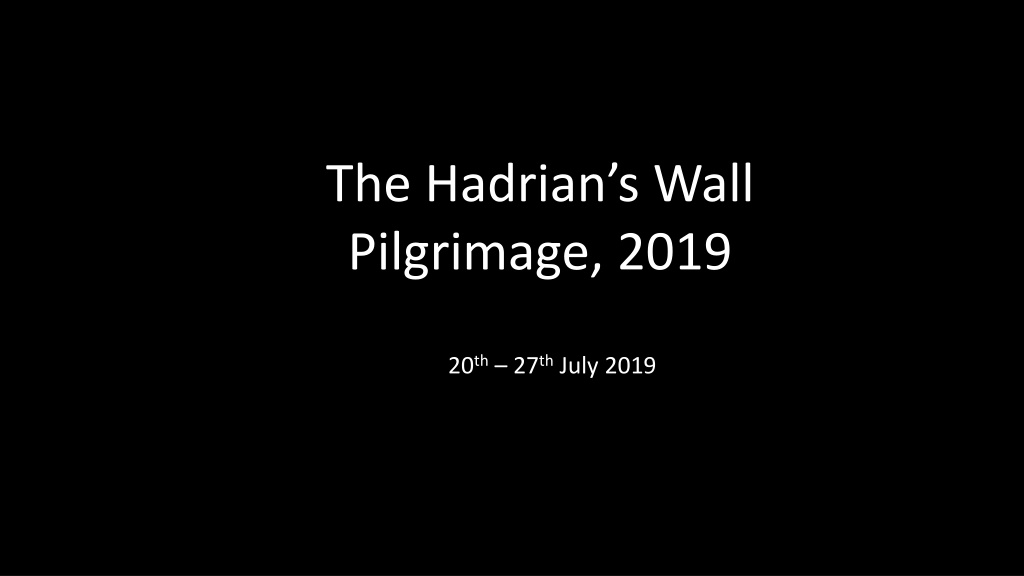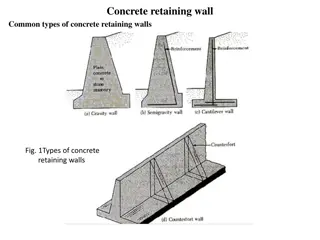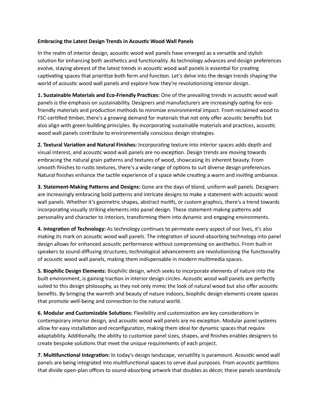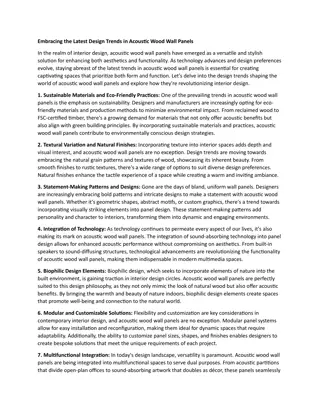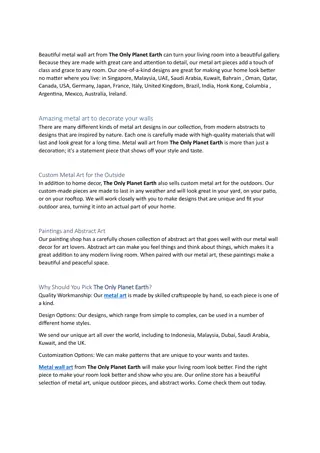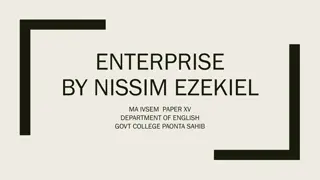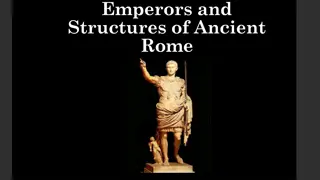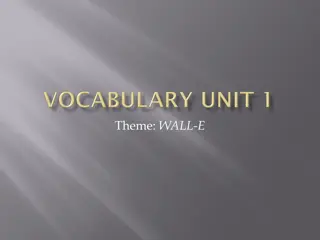The Pilgrimage of Hadrian's Wall - A Memoir of the 2019 Journey
Join the author on their fifth and final pilgrimage along Hadrian's Wall, reflecting on past experiences, challenges, and the enduring mysteries of this ancient landmark. Despite physical limitations, the journey is a poignant exploration of history and friendship against the backdrop of stunning landscapes.
Download Presentation

Please find below an Image/Link to download the presentation.
The content on the website is provided AS IS for your information and personal use only. It may not be sold, licensed, or shared on other websites without obtaining consent from the author. Download presentation by click this link. If you encounter any issues during the download, it is possible that the publisher has removed the file from their server.
E N D
Presentation Transcript
The Pilgrimage The Hadrian s Wall Pilgrimage, 2019 20th 27th July 2019
My Fifth Pilgrimage The Pilgrimage of Hadrian's wall is a venerable institution. The first took place in 1849, and they have taken place every 10 years, gine and take a few intervals. This was my fifth pilgrimage. My first was in 1969, which I reported in CA 15. I then missed out on the 1979 pilgrimage, but I went on the 1989 pilgrimage (CA 116), the 1999 Pilgrimage (CA 164) and the 2009 Pilgrimage (CA240). I wanted to do one last pilgrimage. There was however a problem. I am now 82, and my walking has deteriorated badly - I can t really walk more than a couple of hundred yards at a time. Indeed on the Thursday my knees collapsed when I was getting onto the coach and I gnashed my shin - I am still suffering from it. Nevertheless, even if I could not do any of the long walks, I could still go round the all the forts and the museums, or even walk short stretches: and I was able to meet many old friends and see the Wall for one last time. Here then is my report of the 14th pilgrimage my fifth and last.
We began in the slightly faded splendours of the Royal Station Hotel, Newcastle. It was conveniently situated a hundred yards from the station and was redolent of the glories of the age of steam. We stayed here for four days before moving on to the County hotel at Carlisle.
At the opening dinner I found I was not the only pilgrim wearing a bow tie. I was joined by Sebastian Sommer, the chief archaeologist of Bavaria and the guru of the Roman system in Germany.
Our first stop was at Benwell, the first fort west out of Newcastle. The actual fort is covered by the modern housing estate seen in the photo and the only preserved part is the totally anomalous feature that is the defended gateway over the vallum. The vallum is still one of the great mysteries of Hadrian s Wall, a flat bottomed ditch with banks on either side running up to a mile south of the actual wall. Its purpose remains a mystery it is still tempting to see it as some sort of customs barrier. At Benwell the vallum runs a hundred yards south of the Fort, but uniquely there is a crossing over the vallum with an elaborate Gateway. The flat bottomed ditch can be seen in the photo above, while below is the English Heritage reconstruction drawing. Note the actual Fort in the background.
We continued with our study of the vallum by visiting a section that is virtually unknown in Denton Burn. Here the developers were persuaded to leave a section of the vallum intact and here we see David Breeze, the chief pilgrim explaining the vallum with great enthusiasm Tony Wilmott is in the background. It is rather odd having this somewhat unkempt field in the middle of suburbia, but at least we visited it. We then walked back to the wall itself, seen here alongside the A69, the main road to the West, with traffic thundering past on the dual carriageway
The next visit was the turret 26b, at Brunton and here you see me demonstrating that I can still get over a stile - with some difficulty. Turret 26B is terribly important for wall studies because this is where the Broad wall is replaced by the narrow wall. Hadrian's Wall was originally intended to be 12(?) feet wide, but when they reached turret 26B they decided to narrow it to 10 feet wide. However, the turrets had already been built by a different squad of turret builders, and here you can see the projecting stub at the original broad gauge linking to the narrow gauge.
Chesters We then went on to Chesters which is the first major fort, west of Newcastle laid out for inspection. It is perhaps the nicest of all the forts with the River South Tyne running alongside. But it in the 19th century it was the home of John Clayton, the wealthy Newcastle solicitor who decided to buy up as much of Hadrian's wall as he could in order to preserve it and eventually ended up the owner of four forts and a long stretch of the wall which today is one of the best stretches of the wall. He built a special museum for the sculptures he found on his property. This has recently been restored by English Heritage, following a long discussion whether it should be modernised or restored as a Victorian museum, but it has been restored as Clayton left it: the results is a triumph.
The bath house at Chesters, with the river South Tyne in the background. Note centre bottom the stoke hole for the hot room.
The tepid room in the Chesters bathhouse. Note the window in the far end, one of the few windows to survive from a bathhouse
The Great North Museum In the evening we visited the Great North Museum at Newcastle. This was originally the Hancock Museum of Natural History, but in 2009 it was combined with the University Museum of Antiquities and Brian Shefton s collection of Greek sculpture to form the Great North Museum. The result is highly controversial. The worst exhibit can be seen overleaf: the Museum of Antiquities had a superb model of the course of Hadrian's wall, which was ripped out and replaced with this totally uninformative travesty. We then show a good example of the criticisms aimed at the new Museum: a Roman altar and its caption. The text accompanying the altar is not in fact a translation of the text, but a very misleading paraphrase: the detail is very speculative while the tone is far too cynical and probably wrong. Any schoolchild reading it would will be totally misled about the nature of the Roman Empire.
Above: The Hancock (now Great North) museum. Right: the model of Hadrian s Wall. The only other feature shown is the river Tyne
Matt Symonds explains a milecastle to some of the pilgrims. The altar actually reads: To the goddess Minerva and the Genius of ?? Caecilius Optatus performed his vows
Housesteads Housesteads is the most majestic of the Hadrian's wall forts. It is the highest, the most bleak, but with stunning views, and with the wall stretching away on both sides. When we got there it was blowing a gale and we could scarcely stand up. Luckily, Lindsay Alison Jones took me in her car up to the Museum she knows the secret way up, and then I managed to see the fort. The idea was that we would climb up to the top of the ridge and then walk westwards to see the next milecastle, but having staggered to the top with considerable help, I then saw the pilgrims marching off into the distance and I knew I could not follow them. I decided to explore the Fort, but curses! the West gate was blocked by English Heritage, so that you had to go round to the South gate and pay!
Below. The statue of Victory in the Housesteads museum, set against a fine photo of the best stretch of Hadrian's wall. Museums tend to forget about the background to the objects on display, but here English heritage got it right! Top right. The pilgrims disappearing into the distance. Right below, The West gate, blocked to make you go round and pay!
A stitched together photo looking south from the fort. In the foreground, Tim Tatton Brown is defying the gale and consulting his computer in the Commandant's house. Note the clump of trees half right, which shelters the farm and Museum. When Clayton bought the Fort, there was a farmhouse sheltering in the inside the fort: see painting right, now in Chesters Museum. He therefore moved the farmer out and built a new house for him, now the Museum
David Breeze demonstrates the most mysterious aspect of Housesteads. It appears the wall was originally built without forts, but when it was decided to move the forts up onto the wall, it was decided that the Housesteads fort should project north of the wall. When Richmond was excavating in the 1950s he found traces of the original wall where David is pointing to it
The North gate of Housesteads, facing the Barbarians. It appears to face out onto a steep drop, but there was a ramp leading up to it that was removed in the 19th century to make it more dramatic. But note Hadrian's Wall snaking away into the clump of trees, top right.
South Shields and Wallsend The next day we went back to do the east end of the wall, that is east of Newcastle, where there are two splendid forts at South Shields and Wallsend. South Shields is not strictly a wall fort, but a supply depot situated 5 miles South of the Wall. It was originally excavated in the 19th century as the Roman Remains Park, and it now has some splendid reconstructions. Wallsend is north of the Tyne, and as name suggests, is the end of the Wall. It was originally covered by the houses of the workers of the Swan Hunter shipyard, but in the 1970s the shipyards declined so the whole area was cleared and the fort was excavated.
The first and still the latest magnificent of the reconstructions at our buyer has been that of the Gateway. This was highly controversial at the time because the British tradition does not allow of reconstruction on site, though the German tradition dollars budget has been a great success. The more recently constructions is of the Tribune's house in the South West corner of the Fort and adjacent to it a barrack block by contrast at the barren. In the late Roman period, the commanding officer, a Tribune built a new house for himself in the corner of the Fort set out according to the best Mediterranean traditions and half of this has been reconstructed. The most impressive part is the dining room where the position of or tricking them where the position of the couches could be seeing in the excavation
Two famous tombstones from South Shields. Left is that of Regina (=Queenie?) freedwoman and wife of Barates a Palmyran, though she was by nation a Catuvellaunian (= from St Albans). She died aged 30. What is fascinating is that underneath there is a line of an Aramaic inscription reading Regina, freedwoman of Barates, alas. Top right is the tombstone of Victor, a Moor from North Africa, , who was the freedman of Numerianus, a cavalryman. He died aged 20
Looking across the archaeological Park at Wallsend. On the far side is the Museum and its observation tower from which the excavations can be viewed. In the distance on the right is the River Tyne, where once the steamship Mauritania was built in the Swan Hunter ship yards. A short wall ran from the Fort down to the Tyne to mark the end of the Wall
The newly excavated Roman bathhouse that had been hidden under a pub down by the river
Ten years ago this stretch of the Roman Wall was uncovered and a full-height replica was built behind it. A stream ran through the wall at this point in a culvert and this has now been restored and is being examined by the pilgrims.
The latest plan of the Wallsend fort. The reconstructed section of the Wall and the culvert through the wall is seen centre left, marked Buddle Street. Then the blue line marks the hypothetical line of the stream, now called an aqueduct, leading down to the newly discovered bath house seen two pictures above. The short length of wall leading from the fort down to the river Tyne can be seen to the right
Vindolanda Wednesday, 24 July was change over the day when we changed over from Newcastle to Carlisle and the whole day was devoted to just one site, Vindolanda Vindolanda is magnificent. It is now in the third generation of Burley s, having been begun by Eric, then passed on to Robin, who sadly died last year, and is now taken over by his son, Andrew; though Robin s elder brother Tony is still very much with us and was holding court at the site.
Vindolanda Two remarkable new ideas have come from recent work at Vindolanda. The first is the complete change round that took place in the Severan period, between A.D. 208 12. The whole of the old fort appears to have been given up and filled with roundhouses, laid out very regularly in rows of five, back to back. Meanwhile the civilian settlement, the vicus became the fort or fortlet. It was surrounded by defences, and filled with barracks, workshops and a commanding officers house. The occupation was very short lived, perhaps only four years, but it was very different in the two halves of the fort. The new fort or fortlet produced the usual rich finds, including over 470 boots and shoes from the southern fort ditch: over 40% were from non-adult males, suggesting that women and children were living in the fort. However there were very few finds from the round houses, though analysis of the grains show that the roundhouse dwellers ate mostly barley, rather than wheat: their bread was pretty rough. They were barbarians who did not enjoy the delights of the Roman consumer economy.
The round houses erected in the fort in the Severan
Andrew Birley demonstrating the defences of the vicus in the Severan period when it became the fort.
Christian Vindolanda Another major new concept is a recognition of post-Roman Vindolanda, stretching from the beginning of the fifth century to the ninth century with a vibrant well-organised settlement. The fort was perhaps abandoned from 280 to 303/4 and the new fort had some interesting changes. It appears less coherent, and it appears that several different units may have occupied different parts of the fort. In the late fourth and fifth centuries, several buildings have been interpreted as churches. One of them is a large building adjacent to the old Headquarters building which could have held 50 worshippers or more, with a possible baptismal font just outside, converted from a large water tank inserted by the late Roman cavalry. Right: Late Roman Vindolanda. The top left-hand quarter was still military, with barracks rearranged as individual houses. Below centre left, the two granaries. To their right is what remains of the headquarters building, while centre right is the former commanding officers house with a ?church in the courtyard and a sort of bath house. The bottom right quarter contains at least two possible apsidal buildings, including the large one near the centre with to its left the possible baptistery formed from the former Roman water tank. (Vindolanda Trust)
Vindolanda's church. In the fifth century, there may have been a church at Vindolanda - note the semicircular apse, left.
But the old religion still continued. This shrine to the God Jupiter Dolicenus was discovered just before the last pilgrimage, a splendid altar showing the God as a smith riding a bull . The actual altar is now hidden in the museum, but it is replaced by a replica gleaming a pinkish white, as the original would have done when
Andrew Birley calls this the most terrifying view at Vindolanda. A barbarian entering by the North gate would have been faced with this view down the broad road leading to the headquarters building. Imagine the arched gateway at the centre of the HQ building with two Roman soldiers in full regalia standing on either side. On either side there were the backs of barracks, tall walls without any break in them. It would have looked very grim for a visiting Barbarian
The Vindolanda Museum The Vindolanda Museum, sited in the original Burley family home at Chesterholme has become one of the finest displays of everyday Roman material in the world Because so much of the ground is wet, wood and leather and writing tablets are preserved. One of the most stunning displays is their display of Roman shoes. It is almost impossible to photograph because of the reflections, but that they have literally thousands of shoes in their collections, including many in the latest ladies fashions. However, the champion recent discovery is a set of boxing gloves. Boxing was a cruel sport in the ancient world, but the boxing gloves are displayed on suitable model. I end with a photo of their latest room, Vindolanda s Wooden Underworld, demonstrating the marvels of tree-ring dating. ,
Left. I love this stick figure. just like a child s drawing, but strangely powerful Right The tombstone of poor Ingenuus, who lived twenty four years, four months, and seven days
